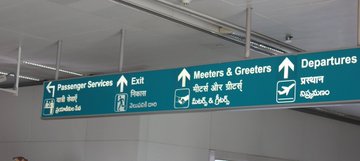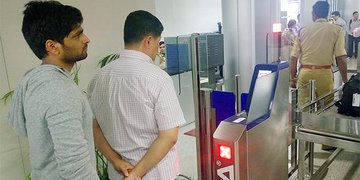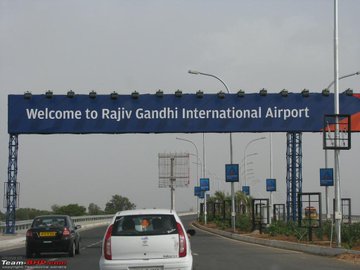IN PICTURES: These 28 Rare Photos of India from the 1900s Will Make Your Day
India has always been a country of contrasts — and of incredible beauty. These 28 photos — taken between 1900—1908 — are not only interesting because they bring to life a past that doesn’t exist any more, but also because the people and places in these photos prove that India has always been a country that is gloriously, exhilaratingly alive. The heart of India beats on.
1. Man dives from the top of a 50 ft tower into a tank below — Fatehpur Sikri

2. State barge of the Maharaja of Kashmir — Srinagar

3. A man and his ox-cart — Kolkata

4. Rock-hewn temple — Elephanta

5. Parsi headmaster and his students — Uran, Navi Mumbai

6. Golden Temple — Amritsar

7. Mahapalika Marg — Mumbai

8. Colonnade at Dilwara Jain Temple — Mount Abu

9. Naldehra — Shimla

10. Inflating bullock-skin boats to cross the river — Banks of the Sutlej

11. Akbar’s Tomb, Sikandara — Agra

12. Temple pillars — Madurai

13. On the banks of the Ganga — Varanasi

14. Funeral procession — Agra

Promotion
15. Lush country surrounding the Dilwara Temples — Mount Abu

16. Shepherds tend their flock — Mount Abu

17. Schoolboys at the Golden Temple — Amritsar

18. Bride and bridegroom — Mumbai

19. The Taj Mahal reflected in the Yamuna — Agra

20. Crowd watches a performing bear — Jaipur

21. Jama Masjid — Delhi

22. Worshippers at Dilwara Temple — Mount Abu

23. Entrance to Akbar’s Tomb at Sikandara — Agra

24. Temple pond — Varanasi

25. Palace of Man Singh — Gwalior

26. Crossing the Jhelum — en route to Kashmir

27. Meditating under the hot sun — Mount Abu

28. Shops on a busy street — Delhi

ALL IMAGES FROM IMGUR.
Like this story? Or have something to share? Write to us: contact@thebetterindia.com, or connect with us on Facebook and Twitter (@thebetterindia).
Sawai Madhopur Railway Station in Rajasthan Got a Complete Makeover. And It Looks Fabulous.
The Sawai Madhopur railway station in Rajasthan has become one of the most beautiful stations in the country, with spectacular paintings and graffiti spread across its walls.
The station that welcomes a large number of tourists every year – thanks to the Ranthambore National Park located in the city, is getting a complete makeover.

The project is being funded by the World Wildlife Fund India (WWF-I), and the station walls now depict the flora and fauna of the region. The vision behind this project is to make tourists aware about conservation in Ranthambore, right from the station itself. The legendary banyan tree of Ranthambore covers one of the station walls – high and mighty, its roots are spread across a large area. Then there are tigers, leopards, hyenas and so much more.
The idea, conceptualized by one India’s most respected wildlife experts and conservationists, Valmik Thapar, was discussed with the Ministry of Railways and they accepted the proposal.
About 20 artists have been working on this project for two months now, and they have covered 7,000 square feet area of the station.

An artist from the Ranthambore School of Art, Gajanand Singh, is leading the work.

“The station has become a living art museum of wildlife. The junglescape has created a buzz. People are curious, excited and are asking questions, taking photographs. It is generating awareness and will have other ripple effects,” Valmik Thapar told DailyO.
A makeover of the Bharatpur railway station with a Bharatpur Bird Sanctuary theme, and painting the coaches of the Kota-Nizamuddin Jan Shatabdi that is often used by tourists going to Ranthambore, are also part of the project in the coming two phases.
The brilliant station will make tourists feel like being in the national park itself.

ALL PICTURES: TWITTER
Like this story? Or have something to share? Write to us: contact@thebetterindia.com, or connect with us on Facebook and Twitter (@thebetterindia).
Moin Can’t Walk, but He Swims like a Champion! And He Wants to Bring Home a Gold Medal for India.
Moin Junaidi is a teenager from Belgaum, Karnataka.
Unlike most other boys his age, Moin cannot walk. What he CAN do, however, is swim — like a champion.

SOURCE: FACEBOOK
Moin has brittle bone disease, or osteogenesis imperfecta, which means that his bones are extremely brittle and highly prone to fracture. For Moin, even a slight bump can cause a fracture. He can neither stand upright nor hold anything in his hands.
Others might let the smallest of setbacks get in the way of pursuing their goals, but Moin hasn’t even slowed down. Despite having over 200 fractures all over his body, Moin is a champion swimmer who has made both Karnataka and India proud.
A huge fan of Shahrukh Khan, Moin got to meet his Bollywood idol in 2014.

SOURCE: FACEBOOK
He has already won medals at the National Paralympics Swimming Competition held in Kolkata, and his brand-new goal is to win the gold medal for India in the next Paralympic Games, in 2016.
We wish you all the best, Moin! You’ve already done us proud.
Boarding a Flight Now Faster with India’s First e-Boarding Facility Launched in Hyderabad
Hyderabad’s Rajiv Gandhi International Airport (RGIA) is now offering e-boarding facility to domestic fliers, becoming the first airport in India to do so. The airport is located at Shamshabad, about 22 km south of Hyderabad.
The facility was inaugurated by the Union Civil Aviation Minister, Ashok Gajapathi Raju, on December 28.
The e-boarding process will include all boarding processes, right from entry into the airport terminal, check-in, security check, boarding gate and boarding bridge check, before entering the plane.

SOURCE: WIKIMEDIA
After receiving and downloading the e-boarding pass on their phones, passengers will only need that mobile e-boarding card, and their Aadhaar card number to board the flight. They will have to flash the e-boarding card at the e-gate bar code readers, after which they will be allowed to proceed towards security check. One can also use the physical boarding pass issued at the check-in counters or the Common Use Self Service (CUSS) machines, but there will be no need to get them manually stamped.
The movement of every passenger using e-boarding facility will be electronically tracked with the help of dedicated CCTV cameras at each checkpoint.
Passengers will also have the option of entering the terminal by showing a photo-ID, in case their Aadhaar number is not available. In this case, once they obtain their boarding pass from the counter or CUSS, they just have to flash the QR Code on it at the e-gate 2D bar code reader, and head for security check. Entry through e-boarding is time bound and guided as per regulations. So the e-boarding reader machine does not allow passengers inside the terminal before the stipulated time. This will help reduce congestion inside the airport.
“We are happy to announce a comprehensive end-to-end E-boarding solution, first time at any Indian airport. After the successful pilot of the project and a go-ahead from Bureau of Civil Aviation Security (BCAS), we have used our internal capabilities to commence E-boarding (facility) in shortest possible time,” RGIA’s Chief Executive Officer, SGK Kishore, told PTI.
Union Civil Aviation Minister, Ashok Gajapathi Raju, said that the facility will be extended to other airports in a phased manner, starting with airports that have high footfall. The entire process has been developed in-house by the GMR Group-led airport.
Like this story? Or have something to share? Write to us: contact@thebetterindia.com, or connect with us on Facebook and Twitter (@thebetterindia).
MY STORY: I Am a Woman Who Has Travelled Solo to 20 States in India. And I Always Felt Safe!
In the MY STORY section, we present some of the most compelling and pertinent stories and experiences shared with us by our readers. Do you have something to share? Write to us: contact@thebetterindia.com with “MY STORY” in the subject line.
Is it safe to travel solo in India? This is a question that many girls who want to hit the road alone have often asked me. Travelling in our country has never been considered to be the safest. And that is precisely the reason why I was initially hesitant about my decision to do the same.
We read stories of different horrific incidents every day, and in that process, we forget that there is a good side of mankind as well. We forget that good people still exist, and they are far more in number than we expect. So when I went to different places and introduced myself, I expected people to raise their eyebrows. But on the contrary, they were all very helpful and appreciative.
I remember how I actually celebrated life as a woman in Bastar, a hinterland of Chhattisgarh.
After spending 96 hours travelling across 1,300 km in this tribal land, I realised that nobody there had touched me, stared at me, groped me or even looked at me in an unusual way. This made me question my urban sensibilities, and the manner in which many of us call these people ‘backward’. The ‘bindass woman selling mahuaat haat bazaar, the old woman selling flowers at Danteshwari temple down South, and the tribal shikari I saw in Barsur forest – all these people made me accept that there is something terribly wrong in our vocabulary when we talk about them.
But I must say, I didn’t venture out as a fearless woman in the beginning.

In fact, I did my research before leaving and checked the Chhattisgarh tourism website for travel advisories and guide books. To my surprise, instead of advising tourists against visiting Bastar, they actually promoted some nature parks, falls, caves and the longest Dussehra festival celebrated there. This gave me the confidence and strength to visit the place
Another surprising and heart-warming event occurred when I was in Rajasthan. One evening, my taxi broke down and I was stuck in the middle of nowhere in the interiors of the state. It was getting dark and there was no one in sight. That was when a couple in their late 50s approached on their tractor and offered to drop me some place nearby where I would get an accommodation for the night and a connecting bus in the morning. I admit that I was initially scared. After all, it is difficult to trust someone so quickly. But I trusted my gut feeling, kept the pepper spray handy and chose to take that 5 km ride. They not only helped me in getting a convenient accommodation for the night, but also made sure that I catch the right bus. I still remember those stories that they narrated on the way – about how they met each other and had a fairy tale wedding.
The next incident is from last year, when I was backpacking in Zanskar on a shoestring budget.

I met a guy in the shared taxi from Kargil, and he offered that I could stay in his cousin’s guest house. My fondest memory of Zanskar is the way they welcomed me and made me feel at home.

They took charge of my entire stay there and made sure that I get to see everything in Zanskar. I didn’t really spend much on this trip. After knowing that I am a vegetarian, they didn’t cook non-vegetarian meals till the time I was there. Grandpa, the eldest person there, also appreciated that I had travelled solo. He narrated many interesting stories of old Zanskar and said that everyone should travel solo once in a lifetime! This was extremely encouraging.
I have experienced generosity from strangers and found people by my side whenever I needed help.

Imagine living in a remote village where people have to trek just to get the basic things but still they are always ready to welcome you. When you see people courageously living in extreme conditions, you tend to stop making excuses about your own life
I guess it’s only when you travel, especially solo, that you get to see and experience the humble side of mankind. Travelling in India has reaffirmed my belief that there is more good in this world than we imagine.

I won’t go so far as to say that people are wrong about their concerns regarding women safety, but that’s half the story. It’s all about travelling smart and having that presence of mind to handle things on the go. There are many challenges when travelling alone in any country, not just India.
So trust your gut feel. As a solo traveller, I have always trusted and listened to my inner instinct, and that has helped me avoid unnecessary circumstances. It’s better to play it safe than be sorry later. Follow the guidelines issued by local authorities and don’t try to be over adventurous. Do a proper research and talk to people who have been there. This is the best way to know about the ground realities.
After backpacking solo in 20 states and covering distance of uncountable kilometers I have realised that we live in a world of pre-conceived notions. We need experience. Travel with open mind and may be you can discover the warmth which I experienced. Challenges may come and go but it will definitely help you to discover the beautiful side of this country that we live in. Happy Travelling!
– Swati Jain
Like this story? Or have something to share? Write to us: contact@thebetterindia.com, or connect with us on Facebook and Twitter (@thebetterindia).
About the author: Swati Jain blogs at buoyantfeet.com
The Future Of Rupesh’s Two Daughters Is Uncertain Due To Yet Another Farmer Suicide
This is a part of our series #SaveFarmerFamilies where we feature the family of a farmer who has committed suicide. We aim to showcase their plight and raise funds to help setup sustainable businesses for these families.

Rupesh Kale used to grow Soyabean and cotton in his 3-acre land.
He was taking good care of his mother, wife and 2-year-old daughter, Monika. It was the year 2010. Monika was jumping with joy when her younger sister, Rupali, came into this world. But Rupesh did not seem to be happy. No, not because it was a girl child. He loved both his daughters more than his life and wanted to give them the best always. But the drought and the loan on his shoulders were not allowing him to do so. This time too he had taken a loan and invested in his farm. He also started working as a farm laborer. But the yield in his farm returned him only half of his investment, which was barely enough to repay the interest. The actual loan remained the same. Rupesh’s frustration was increasing day by day.
And just after 6 months of his younger daughter’s birth, on October 10, 2010, Rupesh consumed Monochrotophos, a pesticide that he used to protect his yield.
This was during the festival of Navratri, when Hindus worship the girl child. Rupesh’s wife, his mother and the two little girls were left in the house to survive through everything that Rupesh left behind.





No comments:
Post a Comment